
* During the 1950s and 1960s, the aircraft manufacturer De Havilland Canada (DHC) acquired extensive experience in the construction of small and medium capacity transports with short take-off & landing (STOL) capabilities, such as the "Otter", "Twin Otter", "Caribou", and "Buffalo". In the early 1970s, DHC decided to create a four-engine turboprop medium STOL airliner, which emerged as the "DHC-7" AKA "DASH-7". The DASH-7 was only built in modest numbers, though it did prove useful as a military surveillance platform. DHC followed it with a twin-turboprop airliner, the "DHC-8" AKA "DASH-8", which proved much more successful. This document provides a history and description of the DASH-7 and DASH-8.
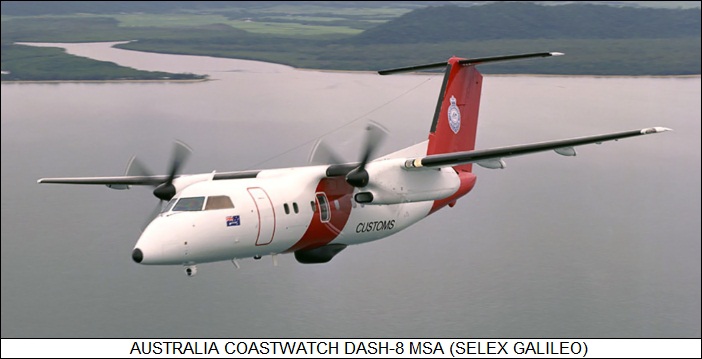
* The DHC-7 / DASH-7 was originally conceived as a mid-sized commercial regional airliner, operating on intercity routes between major metropolitan areas from small local airports. This requirement dictated a design that had good short-field capability and a low noise signature. Construction of prototypes began in late 1972, with the first of two prototypes taking to the air on 27 March 1975 with DHC chief test pilot Robert H. Fowler at the controls. The type received Canadian certification in the spring of 1977, with the first production aircraft flying shortly afterwards. The first customer delivery was in early 1978.
The DASH-7 featured a cylindrical fuselage, high wing with a prominent dihedral, tee tail, and four Pratt & Whitney Canada (PWC) PT6A-50 turboprops, each rated at 835 kW (1,240 SHP) at take-off and driving a four-blade, fully reversible Hamilton Standard propeller. The propellers were wide, with a diameter of 3.4 meters (over 11 feet), to allow them to provide adequate thrust at relatively low RPM, reducing noise. The aircraft featured an aerodynamic lift enhancement system with double slotted flaps over 80% of the wingspan, along with an outboard spoiler on each wing to provide additional control as needed.

With these features, the DASH-7 could take off and land in less than 700 meters (2,300 feet) -- in fact, it is said it could take off at a rate that would leave most passengers thinking they'd left their stomachs back on the runway. In contrast to the DASH-7, a Boeing 737-300 -- which had a degree of short-field capability in the form of thrust reversers and triple slotted flaps -- required about 1,400 meters (4,600 feet) for take-off and landing. The DASH-7 had tricycle landing gear, all assemblies with single wheels, the main gear retracting forward into the inboard engine nacelles and the nose gear retracting backward.
The DASH-7 featured pneumatic de-icing boots on wings and tailplane; presumably the windscreen and engine intakes were electrically de-iced. Avionics kit was conventional, with a weather radar in the nose as standard.
___________________________________________________________________
DE HAVILLAND CANADA DHC-7:
___________________________________________________________________
wingspan:
28.4 meters (93 feet)
wing area:
79.9 sq_meters (860 sq_feet)
length:
24.5 meters (80 feet 6 inches)
height:
8 meters (26 feet 2 inches)
empty weight:
12,540 kilograms (27,650 pounds)
max loaded weight:
21,300 kilograms (47,000 pounds)
cruising speed:
425 KPH (265 MPH / 230 KT)
service ceiling:
7,600 meters (25,000 feet)
endurance:
7.5 hours
___________________________________________________________________
* The initial DASH-7 model was the "Series 100", with seating for 50 passengers in four-across seating, along with pilot, copilot, and one or two flight attendants. Passengers got in and out through an "airstair" door on the left rear, with an emergency exit opposite, and an emergency exit on each side behind the cockpit. The aircraft featured a toilet and galley, plus a baggage compartment in the rear, with the compartment door to the rear of the passenger door on the left side of the fuselage.
A complementary "DHC-7-101" version was also produced, with a cargo door with dimensions of 1.8 x 2.31 meters (71 x 91 inches) in the place of the forward left emergency exit to permit use as a cargolifter or mixed cargo-passenger "combi" transport -- with cargo forward and passengers in the rear, separated by a moveable bulkhead. In the all-cargo role, total volume was 9.34 cubic meters (330 cubic feet) and maximum payload was 4,990 kilograms (11,000 pounds), with the aircraft able to carry palletized cargo or up to five standard LD-3 containers. A roller system could be installed on the floor to ease cargo handling. Combi configurations included:
Executive transport configurations were considered, but nobody ever obtained one.

A "DHC-7-110/111" was offered to meet UK Civil Aviation Authority (CAA) requirements, plus a "DHC-7-150/151" with more fuel, higher take-off weight, and improved passenger accommodations. Other variants were considered but never built. While the DASH-7 was an attractive and well-built aircraft, the urban STOL market that DHC had anticipated never materialized -- to the extent there was a market for a STOL airliner, the Twin Otter could do the job -- and the DASH-7 didn't sell. 108 DASH-7s had been sold to end of production in 1987. Viking Air of Vancouver BC obtained rights to the design.
BACK_TO_TOP* Such DASH-7s as were sold were put to good use. One well-known commercial operator was Air Greenland, with its handful of DASH-7s proving useful in handling the small airfields and rough climate conditions found in the region. The United Nations has also made use of DASH-7s, finding them handy for their ability to operate out of small airfields near disaster zones -- with these machines chartered from commercial firms.
A few DASH-7s were obtained by military and government organizations. Two were used by the Canadian Armed Forces under the designation of "CC-132"; they were more or less conventional passenger-cargo machines. One DASH-7-150 was put into service as the "DASH-7R" or "DASH-7IR" with Transport Canada for the "National Aerial Surveillance Program (NASP)", performing patrol flights over the oceans or the Great Lakes to perform pollution surveys, ice patrols, and general maritime surveillance. This machine was eventually fitted with a second "cockpit" for observers, perched on top of the forward fuselage; as well as a side-looking airborne radar (SLAR), with the radar antenna in a fairing along the lower left side of the fuselage. It could also drop flares and rescue gear.
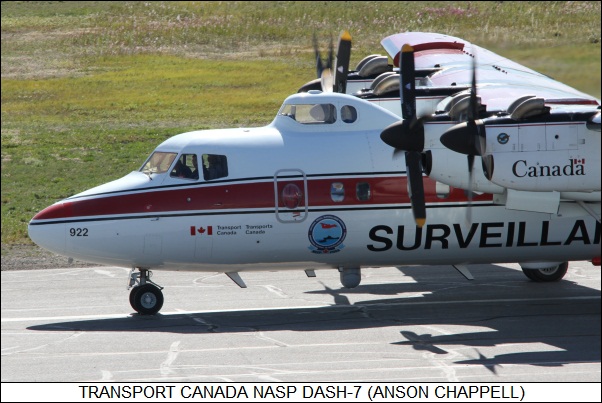
* The US Army had long been a customer of DHC, obtaining aircraft such as the Buffalo for service use, and found the DASH-7 very attractive. In the early 1990s, the US Army Southern Command (SOUTHCOM), with its domain of responsibilities in Latin America, determined a need for a "low profile" intelligence platform to participate in counter-drug operations and other missions that fell outside of the Army's traditional battlefield operations role. The DASH-7 was an excellent choice for the mission. The DASH-7 coupled good endurance and load-carrying capacity with very good short-field performance. Besides, it looked like a civilian airliner and made relatively little noise, which fit the Army's need for an aircraft that didn't attract attention.
The initial contract for converting the DASH-7 into an intelligence aircraft was awarded to California Microwave Incorporated (CMI, now a part of Northrop Grumman) in the spring of 1991, with the first "Airborne Reconnaissance Low (ARL)" aircraft delivered two years later. Three ARLs were provided to SOUTHCOM, with one of them optimized for imaging intelligence (IMINT) and the other two for signals intelligence (SIGINT). The designation "RC-7" was applied to the ARL, though the formal status of this designation remains unclear, since the IMINT machine was given the designation of "O-5A" and the two SIGINT machines the designation of "EO-5B". To confuse matters further, the designation "C-7" was originally applied to the old DHC Caribou.
In any case, along with surveillance gear, the ARLs were fitted with selective kevlar armor and a defensive countermeasures system, with the countermeasures suite including a radar warning unit, a missile warning unit, and chaff-flare dispensers. The ARLs were used in the Haiti intervention in 1994, Bosnian peacekeeping duties, operations against drug producers and smugglers, and in support of disaster relief operations.
* The ARL met SOUTHCOM's requirements very well, and so the Army went on to initiate the acquisition of a more advanced version in the summer of 1993, designated the "ARL-M (ARL Multifunction)", that merged the SIGINT and IMINT functions of the two types of O-5A and EO-5B, along with new capabilities, to provide a comprehensive sensor suite. The designation "RC-7B" was applied to the ARL-M, though again its status was unclear; in 2004, it was formally clarified to "EO-5C", ending the designation confusion. The first two EO-5Cs were delivered in the fall of 1996, and were deployed to Korea to observe North Korean military activities. They replaced the retiring Grumman OV-1D Mohawk. More EO-5Cs were delivered in the following years.
The EO-5C carried a crew of pilot, copilot, and four systems operators. The electronics systems were highly automated to reduce crew workload. The EO-5C could be regarded as sort of a combination poor-man's E-8 "Joint-STARS" battlefield surveillance platform, and RC-135 "Rivet Joint" signals intelligence aircraft. While it didn't have nearly the capabilities of these two larger Boeing four-jet intelligence platforms, the EO-5C was adequate for low-intensity missions, and much cheaper to operate.
CMI bought each aircraft for less than $4 million USD, modified them for about the same amount, and then crammed each bird with $17 million USD in electronics. At a total of about $25 million USD, the EO-5C couldn't be regarded as cheap, but it was about the same price as an F-16 fighter, and far cheaper than a Joint-STARS or Rivet Joint. Its operational costs were similarly lower, about 15% of those of the RC-135. The EO-5C could typically operate for 7.5 hours at 250 KPH, though it could be configured for 10-hour flights.
The EO-5C's payload included:
The EO-5C's sensing and comlink capabilities permitted realtime targeting of adversary assets, allowing ground forces to react quickly to distant threats. Intelligence collected by space satellites could take up to three days to reach its ultimate users, but battlefield commanders down to the battalion level could obtain near-realtime SAR-MTI displays from the EO-5C to give them a view of their tactical environment.
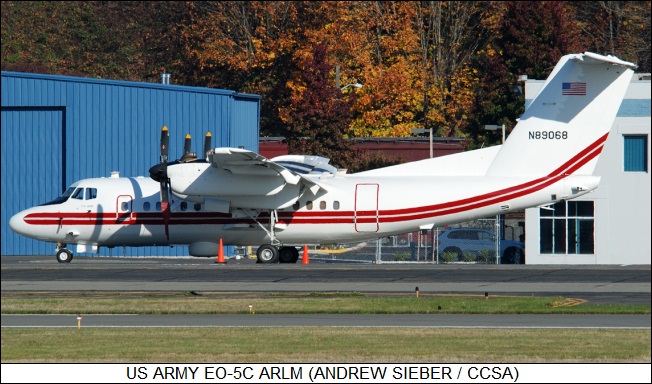
The EO-5C, while hardly invisible to radar or other sensors, adopted a clever kind of "stealth" of its own. The aircraft's "Low" designation implied "low profile", and it was rigged in such a way as to attract little attention. There wasn't much in its external appearance to distinguish it from an ordinary DASH-7, since most of the antennas and other sensors were retractable. It was painted to look like a commercial airliner, with military markings kept to a discreet minimum. During Haiti operations, Caribbean charter pilots took the EO-5C for a new competitor. The name "Crazy Hawk" has been associated with the ARL-M, though that may have been simply the name of a mission the type was assigned to.
* On 23 July 1999, one of the original ARLs, the single O-5A IMINT-only machine, was operating under low-visibility conditions in support of "anti-narcotic" operations in Colombia when it flew into a mountainside. All on board, including both US Army and Colombian military personnel, were killed. The incident revealed both the use of the aircraft in low-profile military operations and the US involvement in the guerrilla war in Colombia.
At the time of the crash, the Army had a total of eight ARLs, plus a DASH-7 used for flight training and another used as a technology demonstrator. Of the surviving seven, two were updated EO-5B SIGINT variants and five were EO-5Cs. Three of the EO-5Cs were deployed to Korea to keep an eye on North Korean military activities north of the demilitarized zone. The US Congress provided funds to replace the 0-5A that was lost, and a new EO-5C was delivered to the US Army.
There was some talk of updating the two SIGINT-only variants to EO-5C specification, as well as a proposal to replace the fleet's PT6A engines with the LHTEC T800 engine; nothing happened along such lines. The Army was in a confusing state of flux over where the service's surveillance fleet was going over the long run; the plan that finally emerged was to replace the DASH-7 ARLs with enhanced platforms based on the DASH-8 airliner, described later. The EO-5Cs were all retired by 2022.
Two other DASH-7s were flown by the Army "Observe Detect Identify & Neutralize (ODIN)" combat task force, operating in Afghanistan from 2010 or so. They carried the "Medium Altitude Reconnaissance Surveillance System (MARSS)", featuring an imager turret, SIGINT gear, and datalinks, plus defensive countermeasures. They were complementary to a fleet of MARSS-configured Beech Super King Airs, and operated by civilian contractors. These DASH-7s have been retired as well.
BACK_TO_TOP* During the 1970s, DHC officials began to consider development of a commuter airliner with 30 to 40 seats that would plug a gap between the 19-seat Twin Otter and the 50-seat DASH-7. The DASH-7 was used as the basis for the "DHC-8" AKA "DASH-8", as the new aircraft was designated, with the DASH-8 featuring a cut-down airframe and twin engines. For powerplants, DHC selected the new PWC PT7 turboprop engine, which would actually go into production as the PW100 series.
The formal launch decision for the DASH-8 was made in 1980, with four preproduction aircraft built: the first performed its initial flight on 20 June 1983, the second on 23 October 1983, the third in 1983, and the last in early 1984. Certification of the initial production model, the "DHC-8-100" AKA "DASH-8 Series 100", was in the last quarter of 1984, with initial deliveries in October 1984.
The DASH-8 Series 100 provides a baseline for the DASH-8 family. It had an obvious resemblance to the DASH-7, with a high wing, tee tail with fin fillet, and roughly similar landing gear arrangement, but there were many detail differences, most notable a shorter and more steeply sloped nose. The standard powerplant was the PW120A, with 1,490 kW (2,000 SHP), driving four-bladed reversible propellers. The more powerful PW121, with 1,600 kW (2,150 SHP), was available as an option. The turboprops were electrically started, and drove four-bladed reversible Hamilton Standard props. An auxiliary power unit (APU) was available as an option on some DASH-8 models.
The Series 100 featured tricycle landing gear, with twin wheels on all assemblies. The electrically-steered nose gear retracted forward, the main gear retracted backward -- not forward as with the DASH-7 -- into the engine nacelles, with the gear featuring an anti-skid braking system. All the flight surfaces and the engine intakes featured pneumatic de-icing boots; props and air data sensors were electrically de-iced. Avionics included, along with typical gear such as radios and radio navigation gear, color weather radar and a digital flight control system, with the cockpit featuring a Honeywell Electronic Flight Information System (EFIS). A head-up display (HUD) was optional.
There was a crew of pilot, copilot, and flight attendant, plus seating for 36 passengers in rows of four. There was a single galley and a toilet, with a baggage compartment in the rear. There was a passenger door on the forward left side of the aircraft, in a swing-down "airstair" configuration; a roll-up baggage / cargo door on the left rear; and an emergency exit on each side of the aircraft just below the leading edge of the wing root, as well as opposite to the passenger door. Of course, the aircraft was pressurized and climate-conditioned.
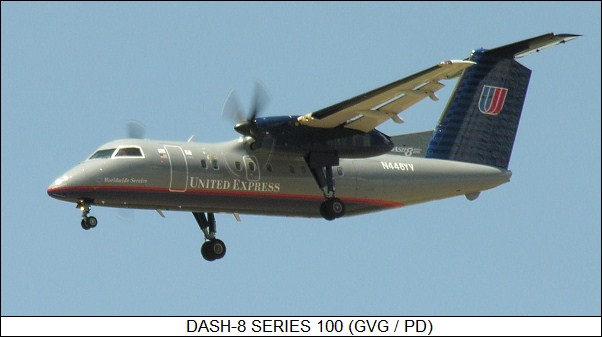
* The original Series 100 was followed by improved subvariants:
The NVS was an "active" noise and vibration cancellation system, involving a set of microphones to pick up noise, with a processor then analyzing the noise and activating a set of transducers in "reverse phase" to cancel out the noise. Avionics in later production were updated, most notably with the addition of an optional Global Positioning System (GPS) satellite navigation system receiver. The Series 100 went out of production in 2005.
___________________________________________________________________
DE HAVILLAND CANADA DHC-8 SERIES 100A:
___________________________________________________________________
wingspan:
25.91 meters (85 feet)
wing area:
54.35 sq_meters (585 sq_feet)
length:
22.25 meters (73 feet)
height:
7.49 meters (24 feet 7 inches)
empty weight:
10,250 kilograms (22,600 pounds)
max loaded weight:
15,650 kilograms (34,500 pounds)
cruising speed:
490 KPH (305 MPH / 265 KT)
service ceiling:
4,900 meters (16,100 feet)
range:
1,920 kilometers (1,195 miles / 1,035 NMI)
___________________________________________________________________
* Consideration was given to a "DASH-8 Series 200", but it was put off for various reasons. The Series 200 finally emerged in 1992 as the "DASH-8 Series 200A", which was externally identical to the Series 100 variants but with PW123C engines providing 1,605 kW (2,150 SHP) for a 55 KPH (35 MPH) increase in speed. Subvariants included:
The Series 200 went out of production in 2009.
* Development of the Series 200 having been put on ice for a few years, it was actually preceded in production by the "DASH-8 Series 300", with first flight on 15 May 1987 -- the year after DHC had been bought out by Boeing -- with certification and introduction to service in 1989. It was effectively a Series 100A machine with extended wingtips, and two fuselage plugs extending the aircraft's length by 3.43 meters (11 feet 3 inches) to increase passenger capacity to 56. PW123A engines with 1,775 kW (2,380 SHP) were standard, with PW123B engines providing 1,865 kW (2,500 SHP) available as an option. Subvariants included:
The Series 300 also went out of production in 2009.
___________________________________________________________________
DE HAVILLAND CANADA DHC-8 SERIES 300A:
___________________________________________________________________
wingspan:
27.43 meters (90 feet)
wing area:
56.21 sq_meters (605 sq_feet)
length:
25.68 meters (84 feet 3 inches)
height:
7.49 meters (24 feet 7 inches)
empty weight:
11,665 kilograms (25,720 pounds)
max loaded weight:
18,640 kilograms (41,100 pounds)
cruising speed:
530 KPH (330 MPH / 285 KT)
service ceiling:
4,115 meters (13,500 feet)
range:
1,525 kilometers (950 miles / 825 NMI)
___________________________________________________________________
* In 1992, DHC was bought from Boeing by the Bombardier Group of Canada. Work began in 1995 on a further enlarged variant, the "Series Q400", with a 6.83-meter (22 foot 5 inch) fuselage stretch relative to the Series 300 to handle up to 78 passengers, as well as a slight increase in wingspan. It had modified control surfaces, new avionics, and was powered by PW150A turboprop engines with 3,800 kW (5,070 SHP) and full authority digital engine control (FADEC). It featured a flight deck developed by Thales with five color flat-panel displays. Initial flight of the first of four Series 400 prototypes was on 31 January 1998, with introduction to service in 2000.
___________________________________________________________________
DE HAVILLAND CANADA DHC-8 Q400:
___________________________________________________________________
wingspan:
28.42 meters (93 feet 3 inches)
wing area:
63.08 sq_meters (679 sq_feet)
length:
32.84 meters (107 feet 9 inches)
height:
8.36 meters (27 feet 5 inches)
empty weight:
17,815 kilograms (37,890 pounds)
max loaded weight:
27,985 kilograms (61,700 pounds)
cruising speed:
665 KPH (415 MPH / 360 KT)
service ceiling:
5,335 meters (17,500 feet)
range:
2,520 kilometers (1,565 miles / 1,360 NMI)
___________________________________________________________________
Seating arrangements for the DASH-8 Q400 included 70, 74, or 78 passengers in a single-class arrangement, or 72 passengers in a two-class arrangement, with ten business seats forward. There were "airstair" passenger doors fore and aft on the left side of the aircraft, with the rear door forward of the baggage door; there were emergency exits on the right side of the aircraft opposite the passenger doors.
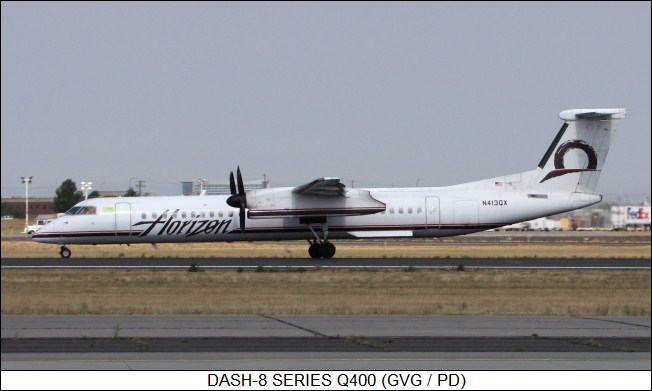
Bombardier introduced a "Q400 NextGen" variant, the primary improvements being a modernized interior featuring LED lighting, and an updated avionics suite, provided by Thales. The first article was rolled out in 2009. An "Extra Capacity" update was introduced in 2013, with maximum seating for 86 passengers -- raised to 90 in 2018. In 2015, Bombardier delivered the first "Q400CC" Combi variant, capable of hauling up to 4,080 kilograms (9,000 pounds) of cargo, along with typical seating for 50 passengers in the forward section. Bombardier never introduced a pure cargo version of the Q400, but "Q400-PF" pallet-freighter conversions are on offer from refit companies.
While the Q400 obviously still has plenty of life left in it, in late 2018 the product line was sold off to Viking Air, Bombardier intending to focus on its business jets. Viking is continuing production of the type, having revived the DHC label for production and sales, and may well roll out further improved variants in time. The new DHC will also upgrade machines already in service; Field Aviation of Toronto has already offered "glass cockpit" upgrades to replace the old "steam gauge" cockpits, with a number of airlines taking them up on the offer. DHC also offers "Simplified Package Freighter" conversions as well.
Several startups are working to perform "zero-emissions" conversions of Q400s, with electric motors driven by a hydrogen fuel cell system. DHC is working with one of them, ZeroAvia, to that end, with the zero-emissions system used both for retrofit and new production. At least early on, the hydrogen system will reduce the number of passenger seats, to no more than 80. A flight demonstrator is in the works.
BACK_TO_TOP* Militarized variants of the DASH-8 were given the designation of "DASH-8M". Canadian forces obtained six DASH-8M-100 machines -- two as more or less stock "CC-142" personnel & cargo transports; six as "CT-142" navigation trainers, with a mapping radar system in an extended nose radome. The CT-142s were given the nickname "Gonzo", after the long-nosed Muppets character. Two DASH-8M-100 machines were also obtained by Transport Canada and kitted up for pollution surveillance; not being military, they were not given any military designation.
The US Air Force obtained two DASH-8M-100 machines under the designation of "E-9A", nicknamed "Widgets", for missile range control, operating out of Florida. These aircraft had telemetry relays for missile and drone control, plus an AN/APS-128D surveillance radar in a belly radome, and a large side-looking phased-array radar in a fairing running along the lower right side of the aircraft.
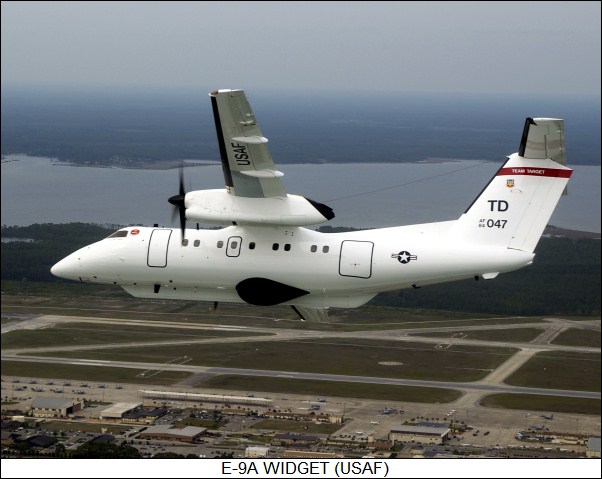
The US Army has also flown special-mission DASH-8s with various sensor fits, some with an elongated nose with an imaging turret underneath. The make-up of the US Army DASH-8 fleet has long been mysterious. It is known that six DASH-8-315 machines were acquired by the Army in 2015 for conversion to sensor platforms, including the "Saturn Arch" and "Desert Owl" configurations, originally defined by ODIN, both of which were focused on defeating improvised explosive devices (IED). There may have been a number of other specialized conversions. These DASH-8 machines were sometimes flown by SOCOM using civilian contractor crews, or owned by civilian contractors and leased out to the Army.
As mentioned earlier, the US Army has replaced their DASH-7 ARL-M machines with nine used DASH-8 Series 300 machines, including some already acquired for other missions. These aircraft were modified to the "ARL Enhanced (ARL-E)" configuration, designated "RO-6A", with one of the machines used as a trainer, being fitted with simulation gear. The exercise was initiated in 2014, with fielding from 2021.
The RO-6A aircraft had EO-IR imaging sensors in dual turrets, along with a laser rangefinder / target designator; a hyperspectral imaging system; a wide-area imaging system; smart SIGINT gear; and datalinks including comsat links, to allow direct intelligence feeds to ground stations and other platforms. Northrop Grumman developed a "Long Range Radar (LRR)", using active-array technology, for the requirement. The machines featured a "plug-&-play" architecture that allowed them to be easily updated, or reconfigured for specific mission requirements.
From 2018, the US Army also obtained two DASH-8-315 aircraft for the service's Golden Knights parachute demonstration team, replacing the Golden Knights' elderly Fokker F-27s. The DASH-8s were designated "C-147A"; they were configured for parachute jump, but had few specifically military optimizations.
Five DASH-8 Series 200A machines were obtained by the Australian Customs Service as "Coastwatch Maritime Surveillance Aircraft (MSA)." These machines were fitted with a Raytheon SeaVue surveillance radar in a belly radome, an electro-optic / infrared imager in a turret under the nose, and a satellite datalink system. They were also fitted with observation ports and a hatch for dropping rescue kit. They were later complemented by five more aircraft, three of them Series 300 variants with additional fuel capacity for longer patrol endurance. The fleet has received updated SeaVue radar, a modernized imager turret, and other updated avionics.
Field Aviation has similarly been performing MSA conversions of DASH-8 aircraft, with several dozen conversions performed to date for customers including Iceland, Japan, Norway, Sweden, and the US Customs & Border Patrol. There are some variations in kit for different customers, but in general the Field MSA conversions feature:
The USCBP flies seven such machines, obtained from 2004 through 2010. They have been upgraded with a new mission system and sensors, with an eye for networking and interoperation with US Coast Guard assets.
Provincial Aerospace of Saint John's, Newfoundland, also performs roughly comparable maritime patrol conversions of DASH-8 machines, with customers including the Netherlands and the UAE.
The US State Department operates Dash-8s modified by TKC Aerospace of Alaska, featuring packs under the nose and the belly, the nose pack featuring windows to the front and the belly pack with windows to each side; not much is known about these machines, but they are apparently operated both as transports and in anti-narcotics operations, the packs presumably being used for mapping imagers.
L-3 Communications of Greenville, Texas, has worked on a Q400 Maritime Mission Aircraft (MMA), which would have additional internal fuel and a weapons bay, along with surface search sensors, including radar and emitter location systems, as well as antisubmarine sensors, including magnetic anomaly detector and sonobouys. It would have an L-3 mission management system derived from one L-3 developed for the Lockheed Martin P-3 Orion. The effort was driven by a British requirement to restore the UK's maritime patrol fleet. However, the British chose to obtain the Boeing P-8 Poseidon, a maritime patrol derivative of the 737 jetliner, and so far nobody has obtained an L-3 Q400 MMA.
Finally, a total of eight used Q400 machines were converted to an "air tanker / water bomber" configuration by the French Securite Civile to fight wildfires. They featured a belly tank, but as per their designation -- "Q400-MR" -- they were multirole machines and could be kitted up for other missions: 64-seat airliner; cargo transport; combi passenger-cargo transport with 19 seats; or medevac. Eight pure air tankers were obtained by the Conair Group under the designation "Q400-AT".
BACK_TO_TOP* Sources include:
Most of the information on the DASH-8 was obtained from various volumes of JANE'S ALL THE WORLD AIRCRAFT.
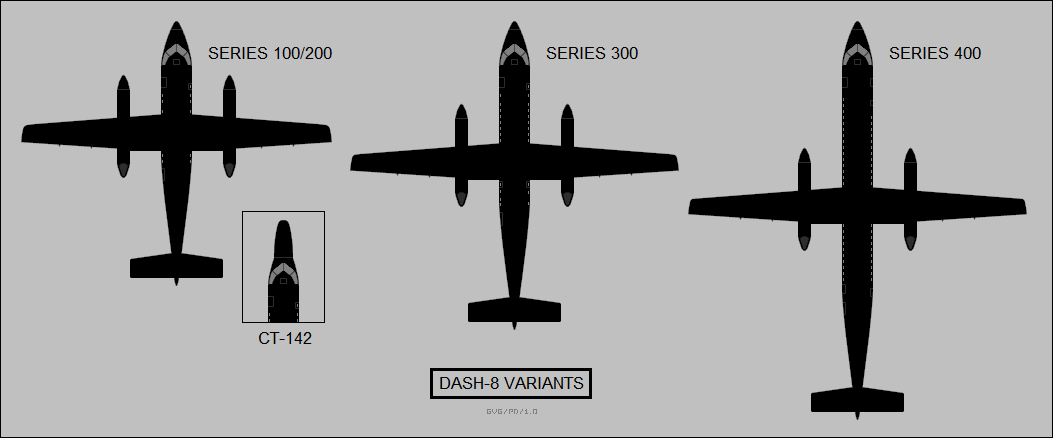
* Revision history:
v1.0 / 01 feb 01 / Started as BATTLEFIELD SURVEILLANCE AIRCRAFT. v2.0.0 / 01 jan 11 / Stand-alone document with DASH-8. v2.0.1 / 01 dec 12 / Review & polish. v2.0.2 / 01 nov 14 / DASH-8 maritime patrol conversions. v2.1.0 / 01 oct 16 / Simplifications, more on special mission machines. v2.1.1 / 01 sep 18 / Review, update, & polish. v2.1.2 / 01 aug 20 / Review, update, & polish. v2.2.0 / 01 jun 22 / Considerable cleanup and update. v2.2.1 / 01 may 24 / Review, update, & polish. (+)
As the history above suggests, this document started life as part of a general document on battlefield surveillance aircraft. I finally decided that the single document didn't make sense and split it into documents on the individual aircraft. The section that was the seed of this document only discussed the DASH-7; I added the DASH-8 and arbitrarily gave it a revcode of v2.0.0.
BACK_TO_TOP